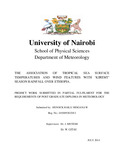| dc.description.abstract | Ethiopia, which is found in the Greater Horn of Africa, enjoys different climatic conditions ranging from temperate to desert. Ethiopia is agrarian country where agriculture employs 84% of the working force and 48% of the countries’ GDP. The climate of the country is driven by different local, regional and global weather systems. Tropical SST and wind features that persist during the Kiremt season and their changes are responsible to the performance of the Kiremt rain season. Teleconnections in the tropical Pacific Ocean are one of the prominent causes of wet and dry Kiremt seasons over Ethiopia. Winds that persist during this season like tropical easterly jet and the southwest monsoons are among the weather features that play role in the performance of the season. As the Kiremt season is the most important season in terms of agriculture and hydropower among other socio-economic sectors, it must be given due emphasis in understanding the weather systems that govern the dynamics of the Kiremt season.
This project aims to investigate the association of tropical sea surface temperatures and wind features with Kiremt rainfall over Ethiopia by investigating the typical tropical SST and wind patterns and their shifts and changes during wet and dry Kiremt seasons.
The project used both conventional and gridded model data sets for the study. Twenty four rainfall stations of 30-34 year rainfall observations will are used in the study. Gridded data sets of sea surface temperature and upper wind data of 34 year span from NCEP-NCAR are used in the project. The methods of analysis included graphical, correlation, and linear regression all used to investigate the association of tropical ocean sea surface temperature and wind features with Kiremt rainfall over Ethiopia.
The results showed that kirmt rainfall over the country responds to various extends to SST variability patterns in the tropical oceans and also to wind features, but there is good pattern association for prediction models. The prediction models using combined SST at various tropical ocean areas, wind at various levels performed reasonably well in prediction of seasonal extremes. The model developed for most of the homogeneous zones have percent correct between 53% to 60%. | en_US |



